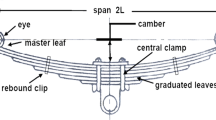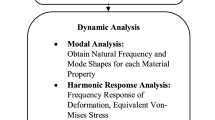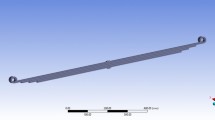Abstract
The automobile industry has shown increased interest in the replacement of steel spring with E-Glass/Epoxy composite leaf spring due to the higher strength-to-weight ratio, superior fatigue strength and excellent corrosion resistance. In this work the composite leaf spring with the rectangular cross section designed for the commercial vehicle was analyzed by using the finite element software ABAQUS, and the experimental tests had been conducted to confirm the finite element analysis results. In the finite element analysis, the stress analysis and the spring rate computation have been conducted for the composite leaf spring subjected to the full load 15,000 N. The maximum compressive stress is 309.1 MPa at the middle of the composite leaf spring, and the safe factor can reach to 2.6 comparing with the material compressive strength of E-Glass/Epoxy 800 MPa. The spring rate computed from ABAQUS is 160 N/mm, and the maximum load capacity of the composite leaf spring is approximately 34,000 N. The measurements of the spring rate and the maximum load capacity were conducted on the composite leaf spring fabricated with the hot molding process method, and they are 157.5 N/mm and 34,280 N respectively. Comparing the results obtained from the finite element analysis with the experimental measurements, it can be seen that the errors are 1.56 % for the spring rate and 0.82 % for the maximum capacity load, and the main performances of fabricated composite leaf spring have the good agreement with the designed requirements.
F2012-E07-004
Access provided by Autonomous University of Puebla. Download conference paper PDF
Similar content being viewed by others
Keywords
1 Introduction
In order to meet the needs of natural resources and economize energy, weight reduction has been the main focus of automobile manufacturer in recent years [1]. Weight reduction can be achieved primarily by the introduction of better material, design optimization and better manufacturing processes. The suspension leaf spring is one of the potential items for weight reduction in automobile. Because of the higher strength-to-weight ratio, superior fatigue strength and excellent corrosion resistance, the fiber reinforce plastics (FRP) has shown increased interest in the replacement of steel spring [2]. When the spring is made of FRP, such as E-Glass/Epoxy, the weight of the spring can reduce 60–70 %, which can leads to reduction of the unsprung weight. The elements whose weight is not transmitted to the suspension spring are called the unsprung elements of the automobile, include wheel assembly, axles, and part of the weight of suspension spring and shock absorbers [3]. The reduction of the unsprung weight could help in achieving the vehicle with improved riding qualities and increased the fuel efficiency. Therefore, the using of composite leaf spring not only leads to the weight reduction, but also improves the riding qualities.
Some works have been conducted with emphasis on the design and application of composite leaf spring, and part of them are reviewed here. Breadmore introduced the application of composite structures for automobiles [4, 5]. Moris concentrated on using composites in the rear suspension system [6]. Yu and Kim [2] designed and optimized a double tapered beam for automotive suspension leaf spring. Corvi [7] investigated a preliminary approach to composite beam design and used it for a composite leaf spring. Rajendran and Vijayarangan developed the genetic algorithms for the design optimization of light weight vehicle composite leaf spring [8], and Shiva Shankar and Vijayarangan [1] investigated the light weight vehicle composite leaf spring concentrated on the end joint analysis and testing. However, there is the limitation for the above research that the designed composite leaf spring is used for the light weight vehicle with static full load below 10,000 N for one spring. Nowadays, with the development of the automobile industrials, the composite leaf spring with more load-bearing is needed. Meanwhile, the structure, material and the fabricate process are all important. Therefore, it is necessary to investigate the composite leaf spring from simulation and experimental test, as well as verify the effectiveness and safety for the heavier load-bearing composite leaf spring.
In this paper the composite leaf spring with rectangle cross section that the constant thickness and width is 28 × 80 mm is designed for the Commercial vehicle with 15,000 N full load for one spring. The finite element (FE) method is used for the analysis of stress state, computation of numerical spring rate and the maximum load capacity. Meantime, for the validity of the designed spring, the experiment is conducted on the composite leaf spring fabricated by the hot molding process. The measured spring rate and the maximum load capacity are compared with the FE analysis results. This work develops the application of the composite leaf spring for the automobile industrial.
2 FE Model of the Composite Leaf Spring
According to the working and assembly conditions and considering the facility of mass production, the mono spring with constant rectangle cross section is employed for the Commercial vehicle. The geometry structure of the spring can be described as follow. The constant thickness and width is 28 × 80 mm, the total length is 1,300 mm, the arc radius is 1,080 mm. Besides, the full loading is 15,000 N, and the designed spring rate is 160 N/mm. The 3-D structure can be obtained in the ABAQUS software as shown in Fig. 1, and the model is meshed with C3D8I [9] as shown in Fig. 2. The dimension of the elements is approximately 5 mm, and there are 20,000 elements. Because the composite leaf spring is mainly subjected to the moment loading, and the tensile and compressive bending stress is along the longitudinal direction. Therefore, the unidirectional fiber glass is selected to be laid up along the longitudinal direction of the spring, and the material properties of the E-Glass/Epoxy are listed in Table 1.
3 FE Analysis of the Composite Leaf Spring
According to the loading condition, the full load 15,000 N is applied at the middle of the composite leaf spring, and the stress along the longitudinal direction can be obtained in Fig. 3. It can be seen that the maximum stress is at the middle location, compressive stress for the outer surface and tensile stress for the inner surface. Meanwhile, the absolute value of the inner surface stress is larger than the one of the outer surface, which may be due to that the composite leaf spring is the curved beam [10]. According to the material properties as given in Table 1, the compressive strength of composite material is smaller than tensile strength, so the verify of the stress strength should be based on the compressive strength. The maximum compressive stress is 309.1 MPa at the middle of the composite leaf spring as shown in Fig. 3. Combining the compressive strength in Table 1 and the compressive stress in Fig 3, it can be calculated that the safety factor is 2.6.
Spring rate is an important parameter for the spring assembled in the vehicle suspension, and it can be computed from the FE analysis as described as follow. During the FE analysis, the variables such as the applied load and the displacement of the composite leaf spring can be recorded, and the load–displacement curve can be plotted in Fig 4. It can be seen that the slope is almost constant during the analysis process, and the relationship of the load and the displacement can be fitted as the linear function by the origin software
where x and y represent the displacement and load respectively, and 160 should be the spring rate. The second part 59.6 should be the deviation which is introduce by the FE simulation and the function fitting. The error can be calculated as 59.6/15,000 × 100 % = 0.40 %, and it can be neglect in the engineer application.
The maximum load capacity is another important parameter for application of the composite leaf spring. Theoretically, when the maximum compressive stress of the composite leaf spring is equal to the compressive strength, the spring will be fractured, and the load should be the maximum load capacity. During the FE analysis, the maximum load is set from 20,000 to 70,000 N, and the increasing step is set as 2,000 N. When the load is increased to 34,000 N, the stress state of the composite leaf spring can be obtained as shown in Fig. 5. The maximum compressive stress is 819.0 MPa, which is just larger than the stress strength 800 MPa. Therefore, it is suggested that 34,000 is the maximum load capacity of the composite leaf spring.
4 Experimental Testing
The designed composite leaf spring had been fabricated with the hot molding process method, and the three-point bending experiment is conducted to measure the spring rate. The composite leaf spring is loaded from zero to the prescribed maximum load 15,000 N and back to zero with loading speed 200 N/s. After five cycles, the load–displacement curves can be obtained as given in Fig. 6, and five spring rates were computed from the curves, listed as 160.2, 154.9, 156.2, 157.0 and 159.2 N/mm. The averaged value is computed and taken as the final spring rate, which is 157.5 N/mm. Comparing the experimental results with the value 160 N/mm obtained from FE analysis in Sect. 3, the error is 1.56 %, and they have the good agreement.
After the measurement of the spring rate, the maximum load is modified as 70,000 N, which is about two times of the maximum load capacity theoretically. The loading speed is set as 200 N/s, and the loading process is stopped automatically when the composite leaf spring is fractured. The recorded load–displacement curve is obtained as shown in Fig. 7, and the maximum load capacity can be extracted from the curve, which is 34,280 N. Comparing the experimental result with the value 34,000 N computed by ABAQUS, the error is 0.82 %.
5 Conclusions
The designed composite leaf spring for the commercial vehicles is analyzed by the FE analysis and experimental test. In the FE analysis, the spring rate and the maximum load capacity are computed by ABAQUS software, and they are 160 N/mm and 34000 N respectively. In the experimental tests, the three-point bending experiments of composite leaf spring fabricated with the hot molding process are conducted, and the tested spring rate and maximum load capacity are 157.5 N/mm and 34280 N. Comparing the results obtained from the FE analysis with the experimental tests, it can be seen that the error is 1.56 % for the spring rate and 0.82 % for the maximum capacity load, and the main performances of fabricated composite leaf spring meet the designed requirements. In this work the delamination damage between the layers in the composite leaf spring is not considered, which will be investigated in the next step.
References
Shiva Shankar GS, Vijayarangan S (2006) Mater Sci 12:220–225
Yu WJ, Kim HC (1988) Comp Struct 9:279–300
Tanabe K, Seino T, Kajio Y (1982) SAE 820403:1628–1634
Beardmore P, Johnson CF (1986) Comp Sci Technol 26:251–281
Beardmore P (1986) Comp Struct 5:163–176
Morris CJ (1986) Comp Struct 5:233–242
Corvi A (1990) Comp Struct 16:259–275
Rajendran I, Vijayarangan S (2001) Comp Struct 79:1121–1129
Simulia (2007) Abaqus user’s manual, Abaqus Version 6.7.1. Dassault Systemes
Hibbeler RC (2010) Mechanics of material. Pearson Education Publications, New Jersey
Author information
Authors and Affiliations
Corresponding author
Editor information
Editors and Affiliations
Rights and permissions
Copyright information
© 2013 Springer-Verlag Berlin Heidelberg
About this paper
Cite this paper
Wang, J., Li, Z., Jiang, Q. (2013). The Analysis of Composite Leaf Spring by Finite Element Method and Experimental Measurements. In: Proceedings of the FISITA 2012 World Automotive Congress. Lecture Notes in Electrical Engineering, vol 195. Springer, Berlin, Heidelberg. https://doi.org/10.1007/978-3-642-33835-9_74
Download citation
DOI: https://doi.org/10.1007/978-3-642-33835-9_74
Published:
Publisher Name: Springer, Berlin, Heidelberg
Print ISBN: 978-3-642-33834-2
Online ISBN: 978-3-642-33835-9
eBook Packages: EngineeringEngineering (R0)











